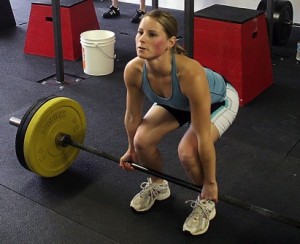Movement, Stability & Then Mechanics
“Proper Body Mechanics” is a hot topic in any sport. Perhaps because over decades of research, video analysis and studying elite athletes there are seemingly very common trends on how to exceed in sports.
Whether throwing a baseball, shooting a hockey puck, or putting in a header, there is an “ideal” way to perform these tasks to optimize results. So the most important thing for any coach or trainer to focus on is body mechanics? Not necessarily.
Do you have a tennis player that always falls short of full extension with a serve? How about an athlete that can’t keep proper knee alignment with a squat?
There is a concept that precedes body mechanics, something much more fundamental than the correct foot position when lining up with a 7 iron.
It is this: Can your body physically do what you are asking it to do?
Movement: Making Motion
 The human body is designed with 200+ bones that provide structure for movement to occur.
The human body is designed with 200+ bones that provide structure for movement to occur.
Among all those bones are a bunch of different joints, with distinct functions that allow various types of movement.
Hip and shoulder joints are designed for motion in all directions, knees and elbows in one direction, and ankles and wrists use a series of joints and bones to make little circles.
Laying on top of this structural support and center of movement are muscles, tendons, ligaments and connective tissue that puts humans into motion. Functional movement is very important.
PRO TIP: If an athlete cannot functionally move in the way that is ideal for athletic performance then that has to be addressed first.
Stability: Controlling Movement
Stability in a broader sense is the ability to generate motion while remaining in control. You want a car with a “stable chassis” which allows for moving at high speeds while keeping everything together. The athletic body craves the same ability to produce ideal body mechanics.
Most relevant to sports and strength conditioning, stability comes from core control. This is the ability to control the arms and legs while providing a stable platform and base of support.
It can be said that you only are as fast as your ability to stop. This perhaps is not true where there is plenty of time for the body to slow down, such as a 100m sprint. Otherwise, if an athlete has to change directions quickly, speed will be limited by the brakes.
This extends to throwing a baseball as well, as the rotator cuff has to prevent the shoulder from dislocating after a throw. Sports performance is limited by the ability to stop efficiently, an important consideration when we talk about controlling motion.
PRO TIP: Control is key to sports performance. The ability to control one’s body effectively is what creates an ideal environment for sports success.
Mechanics: Mastering Performance
If an athlete is capable of moving and stopping motion appropriately then everything else is about performance.
Humans have a phenomenal capacity for neural plasticity. This means we are capable of adapting the brain and nervous system to learn new tasks and master them.
So why is mechanics training so important with young athletes? Because learning carries for life.
PRO TIP: Keep preaching the mechanics! In baseball, for every odd throwing style or batting stance there are 99 that all do it pretty much the same way. Proper mechanics is not only about producing home runs, 3 pointers, and touchdowns but it is also about reducing wear and tear.
Every athlete will succumb to the limits of volume at some point, but those limits are significantly reduced when mechanics are crappy.
Dr. Keith Cronin, DPT
About the Author: Keith Cronin
 Keith J. Cronin is a physical therapist and owner of Sports and Healthcare Solutions, LLC. Keith currently supports US Operations for Dynamic Tape®, the “Original” Biomechanical Tape®, providing guidance for education, research and distribution. He graduated with his Doctorate in Physical Therapy (DPT) from Belmont University in 2008 and later earned his Orthopedic Certification Specialist (OCS).
Keith J. Cronin is a physical therapist and owner of Sports and Healthcare Solutions, LLC. Keith currently supports US Operations for Dynamic Tape®, the “Original” Biomechanical Tape®, providing guidance for education, research and distribution. He graduated with his Doctorate in Physical Therapy (DPT) from Belmont University in 2008 and later earned his Orthopedic Certification Specialist (OCS).
Prior to graduate school, Keith was a collegiate baseball player and top-level high school cross country runner. He also had the opportunity to work as a personal trainer (CSCS) prior to his career in physical therapy, providing a very balanced approached to educating fitness and rehabilitation. Keith has focused his career on the evaluation, treatment, injury prevention, and sports conditioning strategies for athletes, with particular attention to youth sports. He currently lives in the St. Louis, MO area with his wife and two daughters, Ella and Shelby.
Prepare Your Athletes To Perform
Learn how to leverage the Long-Term Athletic Development Model to ensure your athletes are prepared to perform. In expert Wil Fleming’s free 7-minute video and PDF checklist, he covers how to create a training system that prepares young athletes to move better, get stronger, and enhance their performance.





